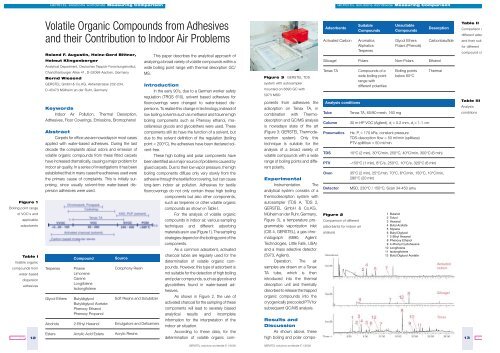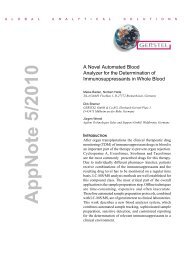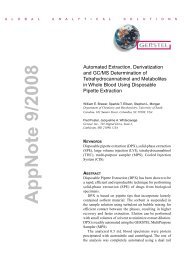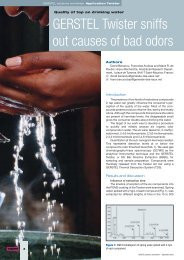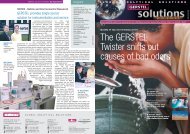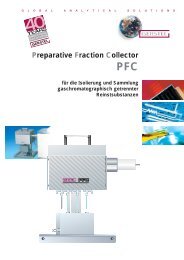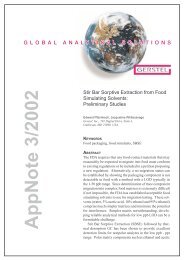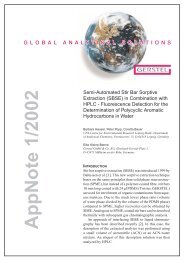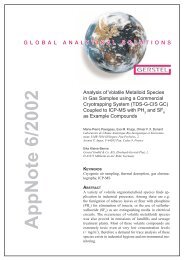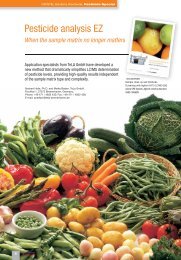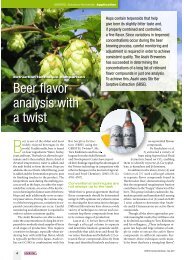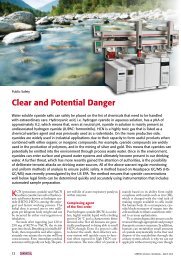Volatile Organic Compounds from Adhesives and their ... - Gerstel
Volatile Organic Compounds from Adhesives and their ... - Gerstel
Volatile Organic Compounds from Adhesives and their ... - Gerstel
You also want an ePaper? Increase the reach of your titles
YUMPU automatically turns print PDFs into web optimized ePapers that Google loves.
GERSTEL solutions worldwide Measuring Comparison<br />
GERSTEL solutions worldwide Measuring Comparison<br />
Figure 1<br />
Boiling point range<br />
of VOC's <strong>and</strong><br />
applicable<br />
adsorbents<br />
Table I<br />
<strong>Volatile</strong> organic<br />
compounds <strong>from</strong><br />
water-based<br />
dispersion<br />
adhesives<br />
12<br />
<strong>Volatile</strong> <strong>Organic</strong> <strong>Compounds</strong> <strong>from</strong> <strong>Adhesives</strong><br />
<strong>and</strong> <strong>their</strong> Contribution to Indoor Air Problems<br />
Rol<strong>and</strong> F. Augustin, Heinz-Gerd Bittner,<br />
Helmut Klingenberger<br />
Analytical Department, Deutsches Teppich-Forschungsinstitut,<br />
Charlottenburger Allee 41, D-52068 Aachen, Germany<br />
Bernd Wiesend<br />
GERSTEL GmbH & Co.KG, Aktienstrasse 232-234,<br />
D-45473 Mülheim an der Ruhr, Germany<br />
Keywords<br />
Indoor Air Pollution, Thermal Desorption,<br />
<strong>Adhesives</strong>, Floor Coverings, Emissions, Bromophenol<br />
Abstract<br />
Carpets for office use are nowadays in most cases<br />
applied with water-based adhesives. During the last<br />
decade the complaints about odors <strong>and</strong> emission of<br />
volatile organic compounds <strong>from</strong> these fitted carpets<br />
have increased dramatically, causing a major problem for<br />
indoor air quality. In a series of investigations it has been<br />
established that in many cases the adhesives used were<br />
the primary cause of complaints. This is initially surprising,<br />
since usually solvent-free water-based dispersion<br />
adhesives were used.<br />
Terpenes<br />
Glycol Ethers<br />
Alcohols<br />
Esters<br />
Compound<br />
Pinene<br />
Limonene<br />
Carene<br />
Longifolene<br />
Isolongifolene<br />
Butyldiglycol<br />
Butyldiglycol Acetate<br />
Phenoxy Ethanol<br />
Phenoxy Propanol<br />
2-Ethyl Hexanol<br />
Acrylic Acid Esters<br />
Source<br />
Colophony Resin<br />
Soft Resins <strong>and</strong> Solubilizer<br />
Emulgators <strong>and</strong> Defoamers<br />
Acrylic Resins<br />
This paper describes the analytical approach of<br />
analyzing a broad variety of volatile compounds within a<br />
wide boiling point range with thermal desorption GC/<br />
MS.<br />
Introduction<br />
In the early 90´s, due to a German worker safety<br />
regulation (TRGS 610), solvent based adhesives for<br />
floorcoverings were changed to water-based dispersions.<br />
To realize this change in technology, instead of<br />
low boiling solvents such as methanol <strong>and</strong> toluene high<br />
boiling components such as Phenoxy ethanol, miscellaneous<br />
glycols <strong>and</strong> glycolethers were used. These<br />
components still do have the function of a solvent, but<br />
due to the solvent definition of the regulation (boiling<br />
point < 200°C), the adhesives have been declared solvent-free.<br />
These high boiling <strong>and</strong> polar components have<br />
been identified as a major source of problems caused by<br />
glued carpets. Due to <strong>their</strong> low vapor pressure, the high<br />
boiling components diffuse only very slowly <strong>from</strong> the<br />
adhesive through the textile floorcovering, but can cause<br />
long-term indoor air pollution. <strong>Adhesives</strong> for textile<br />
floorcoverings do not only contain these high boiling<br />
components but also other components,<br />
such as terpenes or other volatile organic<br />
compounds as shown in Table I.<br />
For the analysis of volatile organic<br />
compounds in indoor air, various sampling<br />
techniques <strong>and</strong> different adsorbing<br />
materials are in use (Figure 1). The sampling<br />
strategies depend on the boiling point of the<br />
components.<br />
As a common adsorbent, activated<br />
charcoal tubes are regularly used for the<br />
determination of volatile organic compounds.<br />
However, this type of adsorbent is<br />
not suitable for the detection of high boiling<br />
<strong>and</strong> polar compounds, such as glycols <strong>and</strong><br />
glycolethers found in water-based adhesives.<br />
As shown in Figure 2, the use of<br />
activated charcoal for the sampling of these<br />
components will lead to severely biased<br />
analytical results <strong>and</strong> incomplete<br />
information for the interpretation of the<br />
indoor air situation.<br />
According to these data, for the<br />
determination of volatile organic com-<br />
Figure 3 GERSTEL TDS<br />
system with autosampler<br />
mounted on 6890 GC with<br />
5973 MSD<br />
ponents <strong>from</strong> adhesives the<br />
adsorption on Tenax TA, in<br />
combination with Thermodesorption<br />
<strong>and</strong> GC/MS analysis<br />
is nowadays state of the art<br />
(Figure 3: GERSTEL Thermodesorption<br />
system). Only this<br />
technique is suitable for the<br />
analysis of a broad variety of<br />
volatile compounds with a wide<br />
range of boiling points <strong>and</strong> different<br />
polarity.<br />
Experimental<br />
Instrumentation. The<br />
analytical system consists of a<br />
thermodesorption system with<br />
autosampler (TDS A, TDS 2,<br />
GERSTEL GmbH & Co.KG,<br />
Mülheim an der Ruhr, Germany,<br />
Figure 3), a temperature programmable<br />
vaporization inlet<br />
(CIS 4, GERSTEL), a gas chromatograph<br />
(6890, Agilent<br />
Technologies, Little Falls, USA)<br />
<strong>and</strong> a mass selective detector<br />
(5973, Agilent).<br />
Operation. The air<br />
samples are drawn on a Tenax<br />
TA tube, which is then<br />
introduced into the thermal<br />
desorption unit <strong>and</strong> thermally<br />
desorbed to release the trapped<br />
organic compounds into the<br />
cryogenically precooled PTV for<br />
subsequent GC/MS analysis.<br />
Results <strong>and</strong><br />
Discussion<br />
As shown above, these<br />
high boiling <strong>and</strong> polar compo-<br />
Adsorbents<br />
Activated Carbon<br />
Silicagel<br />
Tenax TA<br />
Analysis conditions<br />
Tube<br />
Suitable<br />
<strong>Compounds</strong><br />
Aromatics<br />
Aliphatics<br />
Terpenes<br />
Polars<br />
<strong>Compounds</strong> of a<br />
wide boiling point<br />
range with<br />
different polarities<br />
Tenax TA, 60/80 mesh, 160 mg<br />
Unsuitable<br />
<strong>Compounds</strong><br />
Glycol Ethers<br />
Polars (Phenols)<br />
Non-Polars<br />
Boiling points<br />
below 60°C<br />
Column 30 m HP VOC (Agilent), d i<br />
= 0.2 mm, d f<br />
= 1.1 µm<br />
Pneumatics<br />
TDS<br />
PTV<br />
Oven<br />
Detector<br />
Figure 2<br />
Comparison of different<br />
adsorbents for indoor air<br />
analysis<br />
He, P i<br />
= 170 kPa, constant pressure<br />
TDS-desorption flow = 50 ml/min (splitless)<br />
PTV-splitflow = 50 ml/min<br />
Desorption<br />
Carbonbisulfide<br />
Ethanol<br />
Thermal<br />
10°C (2 min), 30°C/min, 250°C, 40°C/min, 300°C (6 min)<br />
–150°C (1 min), 8°C/s, 250°C, 10°C/s, 320°C (6 min)<br />
35°C (2 min), 25°C/min, 70°C, 6°C/min, 150°C, 10°C/min,<br />
280°C (20 min)<br />
MSD, 230°C / 150°C, Scan 34-450 amu<br />
1 Butanol<br />
2 Toluol<br />
3 Hexanal<br />
4 Butyl Acetate<br />
5 Styrene<br />
6 Butyl Diglycol<br />
7 2-Ethyl Hexanol<br />
8 Phenoxy Ethanol<br />
9 4-Phenyl Cyclohexene<br />
10 Longifolene<br />
11 Isolongifolene<br />
12 Butyl Diglycol Acetate<br />
Table II<br />
Comparison o<br />
different adso<br />
<strong>and</strong> <strong>their</strong> suit<br />
for different<br />
compound cl<br />
Table III<br />
Analysis<br />
conditions<br />
13<br />
GERSTEL solutions worldwide E 1/2000<br />
GERSTEL solutions worldwide E 1/2000
GERSTEL solutions worldwide Measuring Comparison<br />
GERSTEL solutions worldwide Measuring Comparison<br />
Figure 4<br />
Adhesive after<br />
7 days<br />
Figure 5<br />
Adhesively fitted<br />
carpet after 7 days<br />
14<br />
nents are not only difficult to detect,<br />
but can also influence the ambient<br />
indoor air to a great extent.<br />
Compared to low boiling solvents,<br />
these chemicals tend to migrate<br />
slowly out of the adhesive into the<br />
textile floorcovering <strong>and</strong> will<br />
furthermore lead to ongoing<br />
emissions of the material. Figure 4<br />
shows a chromatogram of an air<br />
sample taken in a test chamber above<br />
a pure adhesive in comparison to one<br />
of a fitted carpet containing the same<br />
adhesive after 7 days (Figure 5).<br />
Another experiment is shown in<br />
Figure 6. For the determination of longterm<br />
emissions <strong>from</strong> adhesives<br />
(prediction for real rooms), a chamber<br />
measurement has been performed<br />
over 100 days. A carpet, glued on a<br />
glass plate was measured for this long<br />
1 Butyl Diglycol<br />
2 Methoxypropenyl Benzene<br />
3 Phenoxy Ethanol<br />
4 Dimethylbicycloheptene Ethanol<br />
5 Butyl Diglycol Acetate<br />
6 Terpene<br />
7 Longifolene<br />
8 Butyl Triglycol<br />
Figure 6<br />
Long-term<br />
emission (TVOC)<br />
of a glued carpet<br />
in a test chamber<br />
Figure 7<br />
Test chamber<br />
period of time in a test chamber (Figure 7)<br />
to obtain more information concerning<br />
the long-term emission behavior of<br />
glycols <strong>and</strong> glycol ethers.<br />
An actual situation similar to the test<br />
chamber compounds, has lead to a long<br />
lasting emission of volatile components<br />
into the indoor air. As shown in Figure 8 in<br />
a real room situation these high-boiling<br />
components, such as phenoxy ethanol,<br />
do not appear immediately, but instead<br />
after a period of time after installation. In<br />
this particular case, the office had to be<br />
renovated after nine months due to the<br />
complaints of the users <strong>and</strong> according to<br />
the emission data.<br />
Another example shows that air<br />
analysis alone does not necessarily solve<br />
indoor air odor problems. In this case an<br />
extremely annoying bad smell was<br />
reported in an office room. Indoor air<br />
analysis resulted in the detection of<br />
bromophenol (Figure 9), but neither the<br />
floor covering nor the adhesive contained<br />
even traces of this compound. The<br />
combination of carpet <strong>and</strong> adhesive led<br />
to the formation of bromophenol <strong>and</strong><br />
placing a piece of carpet (with the<br />
Figure 8<br />
Real room<br />
situation in a<br />
newly<br />
constructed<br />
office building<br />
adhesive applied) in the thermal desorption unit <strong>and</strong><br />
performing thermal extraction could reproduce the bad<br />
smell.<br />
Figure 10 shows the mechanism of formation:<br />
phenoxy propanol (<strong>from</strong> the adhesive) is hydrolyzed to<br />
phenol, which itself reacts with inorganic bromide (<strong>from</strong><br />
the latex back of the textile covering) forming<br />
bromophenol.<br />
Conclusions<br />
<strong>Volatile</strong> organic components <strong>from</strong> water-based<br />
adhesives have a major influence on the indoor air<br />
quality. Due to the use of high-boiling <strong>and</strong> polar<br />
compounds, the impact of the problem has been shifted<br />
<strong>from</strong> the installation process to the consumer or<br />
inhabitant of the office. The emissions of these<br />
compounds are a major problem of indoor air pollution.<br />
As shown in this paper, the influence of adhesive<br />
components on the long-term emission is substantial<br />
<strong>and</strong> by using the wrong analytical technique the true<br />
magnitude of the problem for the indoor air situation can<br />
be severly underestimated.<br />
After having learned about the situation, a new<br />
testing scheme for the long-term emission of adhesives<br />
was developed by the association of adhesive<br />
manufacturers <strong>and</strong> the association of environmentally<br />
friendly carpets.<br />
Figure 9<br />
Direct thermal<br />
extraction of<br />
carpet material<br />
<strong>and</strong> an adhesive<br />
1 Butanol<br />
2 Methyl Propionic Acid<br />
3 Butyl Isopropylene Glycol<br />
4 Benzaldehyde<br />
5 Phenol<br />
6 2-Ethyl Hexanol<br />
7 Bromophenol<br />
8 Phenoxy Propanone<br />
9 Phenoxy Propanol<br />
10 4-Phenyl Cyclohexene<br />
11 Isolongifolene<br />
12 Longifolene<br />
Figure 10 Mechanism of<br />
formation of bromophenol<br />
Our service <strong>and</strong> sup<br />
network: Distributo<br />
Australia<br />
Lasersan Pty Ltd.<br />
P.O. Box 3279<br />
AUS-Robina Town Centre, QLD,<br />
Phone: +61 (417) 627667<br />
Fax: +61 (7) 5525 2533<br />
Benelux <strong>and</strong> Sc<strong>and</strong>inav<br />
Analytical Applications Brielle B.V<br />
Oever 1, NL-3232 GN Brielle<br />
P.O. Box, NL-3232 AB Brielle<br />
Phone +31 (181) 416555<br />
Fax +31 (181) 418600<br />
France<br />
Analytical Applications Lyon S.A.<br />
7, Place Antonin Poncet<br />
F-69002 Lyon<br />
Phone: +33 (478) 380567<br />
Israel<br />
Eldan Electronic Instrument Co.L<br />
Idan twin building<br />
New industrial park Afek<br />
21 Ha’Melacha st.<br />
IL – 48091 Rosh Ha’Ayin<br />
Phone: +972 (3) 9021330<br />
Fax: +972 (3) 9021331<br />
Italy<br />
Abreg s.r.l.<br />
Via Montello, 20<br />
15100 Aless<strong>and</strong>ria<br />
Italia<br />
Phone: +39 (0131) 325124<br />
Fax: +39 (0131) 510972<br />
Japan<br />
Yokogawa Analytical Systems Inc<br />
Sales Department / Gas<br />
Products<br />
Mitaka Takagi Bldg.<br />
1-15-5 Nakacho, Masashino-shi<br />
J – 180 Tokyo<br />
Phone: +81 (422) 56-9393<br />
Fax: +81 (422) 56-9449<br />
Korea<br />
Young In Scientific Co., Ltd.<br />
Young-Wha Bldg. 547<br />
Shin Sa-Dong, Kang Nam-Ku<br />
Seoul, 135-120<br />
Korea<br />
Phone: +82 (2) 519-7300<br />
Fax: +82 (2) 519-7400<br />
Pol<strong>and</strong><br />
CHROMTEC<br />
Chromatographia Apparature Akc<br />
Ul. Rakowiecka 36/253<br />
PL – 02532 Warszawa<br />
Phone: +48 (22) 6063883<br />
Fax: +48 (22) 8491054<br />
Spain<br />
Andaluza De Instrumentacion S.<br />
Centro de Empresas Aljarafe<br />
Poligono Industrial PISA<br />
C/Horizonte, 7, 3aPlanta, Mod. 1<br />
E-41927 Mairena de Aljarafe – S<br />
Phone: +34 (95) 5600117<br />
Fax: +34 (95) 4182034<br />
United Kingdom<br />
Analytical Applications Reading L<br />
University of Reading<br />
Reading<br />
GB-Berkshire RG 6 6BX<br />
Phone: +44 (1734) 861361<br />
Fax: +44 (1734) 861894<br />
15<br />
GERSTEL solutions worldwide E 1/2000<br />
GERSTEL solutions worldwide E 1/2000


